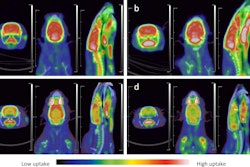
An animal study suggests that PET imaging may be able to help assess the threat that microplastics pose to human health, according to a group in New York City.
A team led by PhD candidate Samantha Delaney, of the City University of New York, chemically labeled microplastic particles with a radioisotope and then tracked the fate of the molecules on PET imaging.
"This work underscores the value of PET imaging as a tool for studying the pharmacokinetics of environmental pollutants," the group wrote, in a study published August 14 in Science of The Total Environment.
The threat that microplastics and nanoplastics pose to human health has fueled research focused on their pathophysiology and toxicology, the authors explained. Yet many of their fundamental properties -- for example, their in vivo pharmacokinetics -- remain poorly understood.
To shed light on the issue, the researchers aimed to harness PET to track the in vivo fate of micro- and nanoplastics administered to mice intratracheally and intravenously.
The group first chemically modified polystyrene particles with a chelating compound that allowed them to radiolabel the plastics with zirconium-89 (Zr-89), an isotope widely used to develop PET radiotracers.
 A graphical abstract. Image courtesy of Science of The Total Environment.
A graphical abstract. Image courtesy of Science of The Total Environment.After administering the radiolabeled plastics, small-animal PET imaging and biodistribution experiments revealed that the particles accumulated primarily in the liver and spleen, yielding significant hepatic activity 168 hours after the injections. In contrast, the mice that received the radioplastics intratracheally displayed the highest uptake in the lungs at the end of one week.
"Ultimately, this work illustrates the critical role that the route of exposure plays in the bioaccumulation of plastic particles," the authors wrote.
Moving forward, the team plans to include the use of weathered plastic particles and materials beyond polystyrene (such as polypropylene and polyethylene) as well as create a model that recapitulates chronic exposure.
"In the end, it is our hope that this work not only demonstrates the utility of molecular imaging as a tool for assessing the in vivo behavior of micro- and nanoplastics but also represents a starting point for the use of these techniques for the analysis of all environmental pollutants," the group concluded.
The full article can be found here.





















